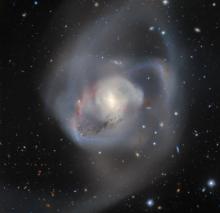Listen to today's episode of StarDate on the web the same day it airs in high-quality streaming audio without any extra ads or announcements. Choose a $8 one-month pass, or listen every day for a year for just $30.
You are here
Galaxies
We have lots of addresses. After your street address, city, state, and country, you might add lines for Planet Earth, the solar system, and the Milky Way Galaxy.
The Milky Way is just one of 200 billion galaxies or more in the present-day cosmos. Each one is an “island universe” — a vast collection of stars, gas and dust for making new stars, and mysterious “dark matter.”
Galaxies come in a few basic layouts. Many of them are wide, thin disks like the Milky Way. Waves traveling through the disks form beautiful spiral arms, so the galaxies look like pinwheels.
Others are shaped like fuzzy rugby balls. Their stars are old, and the galaxies don’t have much gas for making more stars. And still others are blobs with no easily definable shape.
There’s huge variety within these groups. Some galaxies are little more than puffballs. They’re only a few dozen to a few hundred light-years wide, and they contain only a few hundred million stars — a tiny fraction of the size and population of the Milky Way.
At the opposite end of the scale are the largest galaxies. They span a million light-years or more, and they host a hundred trillion stars — numbers that dwarf the Milky Way.
With so many galaxies around, it’s inevitable that they occasionally sideswipe each other, or even ram together head-on. In the end, the galaxies may merge, forming even bigger “island universes.”
We’ll talk about about one example of merging galaxies tomorrow.
Script by Damond Benningfield





